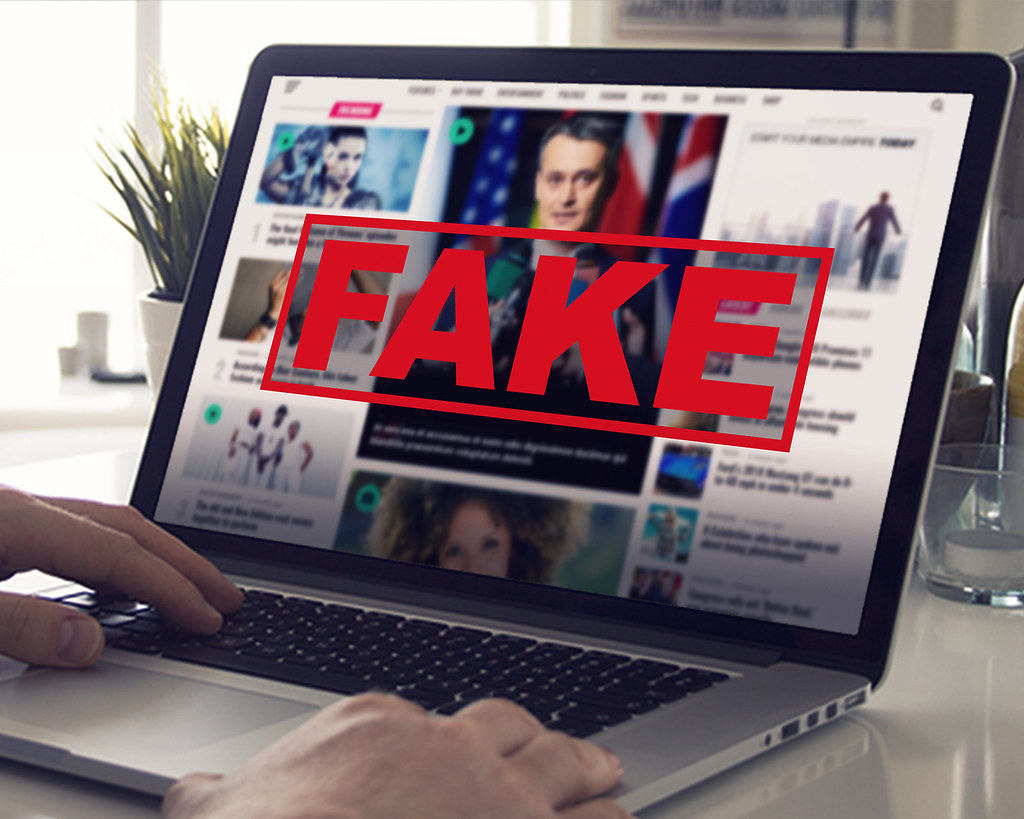Published: September 30th, 2023

“Fake News – Computer Screen Reading Fake News” by mikemacmarketing is licensed under CC BY 2.0.
Social media has become the central platform for information and communication for the vast majority of people around the world. According to Statista, global social media users will exceed 4.89 billion in 2023, and the global social media usage rate has reached 59 percent (Dixon, 2023). Along with social media’s popularity and growth, disinformation has become increasingly prominent and a severe threat to economic, political, and social stability. Data show that more than 50 percent of users in 23 countries use social networks to get news (Watson, 2023). This trend means that social media has changed how people communicate and build relationships and influenced how people access information and form ideas. As a result of this change, people are increasingly exposed to various information streams but, at the same time, have become more susceptible to the erosion and influence of disinformation. False information covers a wide range of areas on social media platforms, with sources including misleading advertisements, inaccurate news reports, and artificially created false rumors, which seriously distort users’ perceptions and lead to a range of socio-economic problems.
This article will delve into the multifaceted economic and political impact of disinformation in social media. The article will analyze how disinformation erodes consumer trust, damages corporate reputation, distorts market mechanisms, and leads to economic imbalances. It will also explore how disinformation affects the formation and dissemination of political opinions and its potential impact on voter behavior, social stability, and national security.
Economic impact of disinformation on social media platforms
Social media platforms have become a significant channel for linking businesses and consumers because of their convenience and broad user reach. Many companies use social media for marketing, advertising, and customer interaction. However, the proliferation of false information on the platforms seriously threatens businesses and the economy. A study conducted by cybersecurity firm CHEQ in conjunction with the University of Baltimore reveals the enormous burden online fake news places on the global economy (University of Baltimore, 2019). Phony news causes about $78 billion in economic losses each year. It also costs about $39 billion in stock market value.
Firstly, false information severely erodes consumer trust in platforms. Social media user trustworthiness has dropped to 35% (Edelman, 2021). User trustworthiness will directly affect the platform’s user engagement. Due to the openness and convenience of social media platforms, false information can spread quickly when the platform’s algorithm prioritizes pushing popular rather than authentic content. Users repeatedly exposed to false news may enhance their trust in false news and lead to skepticism and distrust of the facts. However, when users realize that the news they receive is fake, platforms can experience user churn and declining trust. For example, Facebook lost 700,000 active users in 2017 (University of Baltimore, 2019).
Secondly, false information can seriously damage a business’s reputation. Once a business is associated with false news or information, it is difficult for its reputation to recover fully, even if the information is proven incorrect. This affects a company’s market share and stock price and can lead to a massive loss of customers, which can have a severe negative economic impact on a company’s long-term development (Velichety & Shrivastava, 2022). The 2016 “Pizzagate” incident is a classic example of false news spread on social media. In that incident, a completely unsubstantiated false news story spread rapidly on social media, claiming a pizza restaurant was involved in a child sex abuse ring run by a high-level political figure (BBC Trending, 2016). Although the news was quickly proven false, it led to public panic and an actual threat to the restaurant. This shows how false information on social media platforms can have an irreversible economic impact on real businesses.
The impact of disinformation on social media platforms in politics on people

“A hospital corpsman prepares a COVID-19 vaccine.” by Official U.S. Navy Imagery is licensed under CC BY 2.0.
Disinformation is a global problem on social media platforms with far-reaching political implications. Such information can sway the public’s views and opinions, further influence their voting decisions, and may even lead to tearing and antagonizing societies. The information and news on social media platforms undoubtedly significantly impact public opinion and users’ mindsets. As a result, the harmful and false information users are exposed to will inevitably interfere with and distort their perceptions and judgments of current events.
In the 2016 US presidential election, disinformation on social media platforms such as Facebook and Twitter was seen as possibly impacting voters’ voting decisions. Such disinformation included false allegations about candidates, incorrect notifications of election dates, and false warnings of voter fraud, among others (Allcott & Gentzkow, 2017). The previously mentioned “Pizza-gate” scandal caused economic loss to the entity, and the conspiracy theory falsely claimed that Hillary Clinton was involved in a child sex trafficking network at a pizza restaurant. Although there was no evidence to support the allegation, the news spread rapidly on social media and even led to malicious threats of physical assault (Kang & Goldman, 2016). This extreme event highlights disinformation’s severe and destabilizing impact on the real world.

“11 28 2021 Stop Anti Asian violence Q Gardens” by Wil540 art is licensed under CC BY-SA 4.0.
At the same time, during the COVID-19 pandemic, disinformation on social media undoubtedly exacerbated social divisions and conflicts, severely disrupting public health and vaccination efforts. Social media platforms were rife with misinformation and conspiracy theories about the COVID-19 vaccine, making many people skeptical and fearful of the vaccine (Ahmed & Rasul, 2022). Data suggests that 1,274 out of 1,500 tweets are false (Ferreira Caceres et al., 2022). This misinformation contains erroneous reports and unsubstantiated claims about vaccine ingredients, side effects, the manufacturing process, and their long-term effects. This information environment must be clarified for public trust in official health guidelines and government recommendations (Gover et al., 2020).
Moreover, disinformation fuelled divisions and antagonisms between different societal groups.COVID-19 was dubbed the “Chinese virus” by the media in its early stages, a nomenclature that quickly spread on social media. This virus’s association with particular countries or regions fuelled discrimination and prejudice against these regions and their people, leading to hate crimes and anti-Asian incidents.
Is the current approach to disinformation really effective?

“Is “Fake News” a Real Problem in Latin America?” by InterAmericanDialogue is licensed under CC BY 2.0.
From a user perspective, improving media literacy is vital. Users need to develop critical thinking and learn to distinguish between the authenticity of information and how to obtain information from reliable sources. From the government’s monitoring perspective, the government can implement stricter laws and regulations requiring social media platforms to strengthen their content auditing and management and promptly detect and deal with false information. At present, preventing the intrusion of incorrect information is mainly divided into seeing false information and disseminating the truth (Li & Chang, 2022). The technology developed to detect misinformation automatically is used to verify every content posted on social media platforms. It is not enough to see misinformation; it is also necessary to ensure that facts and truth are widely disseminated (Li & Chang, 2022).
However, people prefer to get information from sources that align with their beliefs and opinions. The filter bubble algorithms employed on social media platforms further contribute to the increased bias and social polarisation of the information received by users. Filter bubbles limit users’ exposure to a diversity of viewpoints. Even if facts and truths are detected and verified in such cases, they may be difficult to convey to a broader group of users due to the limitations of the algorithms—especially those users who are deeply involved in untrue information and extreme views. Therefore, relying solely on existing misinformation detection techniques and fact-checking mechanisms can only partially address disinformation. Social media platform regulation also needs to reconsider how to break down the information barriers built by algorithms. Social media companies can improve the public’s media literacy and critical thinking skills, strengthen the regulation of their platforms, and develop more diverse recommendation algorithms.
References
Ahmed, S., & Rasul, M. E. (2022). Social Media News Use and COVID-19 Misinformation Engagement: Survey Study. Journal of Medical Internet Research, 24(9), e38944. https://doi.org/10.2196/38944
Allcott, H., & Gentzkow, M. (2017). Social Media and Fake News in the 2016 Election. Journal of Economic Perspectives, 31(2), 211–236. https://doi.org/10.1257/jep.31.2.211
BBC Trending. (2016, December 2). “Pizzagate”: The fake story that shows how conspiracy theories spread. BBC News; BBC News. https://www.bbc.com/news/blogs-trending-38156985
Dixon, S. (2023, August 29). eResources, The University of Sydney Library. Login.ezproxy.library.sydney.edu.au. https://www-statista-com.ezproxy.library.sydney.edu.au/statistics/278414/number-of-worldwide-social-network-users/
Edelman. (2021). 2021 Edelman Trust Barometer. Edelman. https://www.edelman.com/trust/2021-trust-barometer
Ferreira Caceres, M. M., Sosa, J. P., Lawrence, J. A., Sestacovschi, C., Tidd-Johnson, A., Rasool, M. H. U., Gadamidi, V. K., Ozair, S., Pandav, K., Cuevas-Lou, C., Parrish, M., Rodriguez, I., & Fernandez, J. P. (2022). The impact of misinformation on the COVID-19 pandemic. AIMS Public Health, 9(2), 262–277. https://doi.org/10.3934/publichealth.2022018
Gover, A. R., Harper, S. B., & Langton, L. (2020). Anti-Asian hate crime during the COVID-19 pandemic: Exploring the reproduction of inequality. American Journal of Criminal Justice, 45(4), 647–667. https://doi.org/10.1007/s12103-020-09545-1
Kang, C., & Goldman, A. (2016, December 5). In Washington Pizzeria Attack, Fake News Brought Real Guns. The New York Times. https://www.nytimes.com/2016/12/05/business/media/comet-ping-pong-pizza-shooting-fake-news-consequences.html
Li, J., & Chang, X. (2022). Combating Misinformation by Sharing the Truth: a Study on the Spread of Fact-Checks on Social Media. Information Systems Frontiers: A Journal of Research and Innovation, 1–15. https://doi.org/10.1007/s10796-022-10296-z
University of Baltimore (Ed.). (2019). THE ECONOMIC COST OF BAD ACTORS ON THE INTERNET. https://info.cheq.ai/hubfs/Research/THE_ECONOMIC_COST_Fake_News_final.pdf
Velichety, S., & Shrivastava, U. (2022). Quantifying the impacts of online fake news on the equity value of social media platforms – Evidence from Twitter. International Journal of Information Management, 64, 102474. https://doi.org/10.1016/j.ijinfomgt.2022.102474
Watson, A. (2023, September 25). eResources, The University of Sydney Library. Login.ezproxy.library.sydney.edu.au. https://www-statista-com.ezproxy.library.sydney.edu.au/statistics/718019/social-media-news-source/


